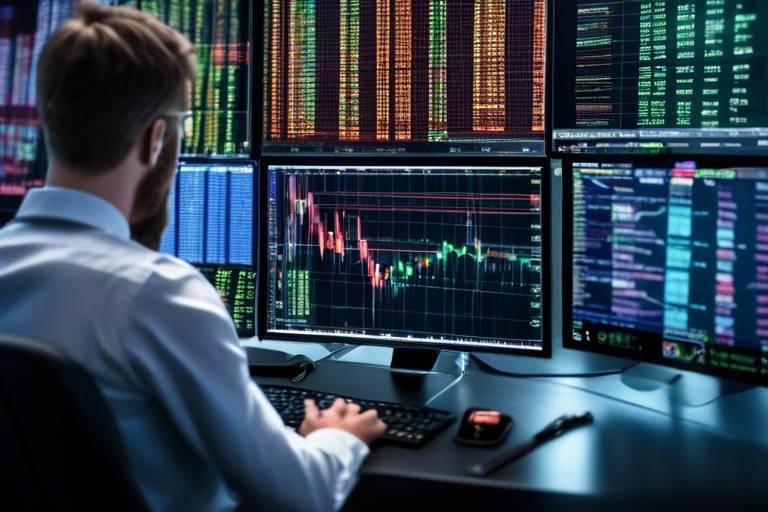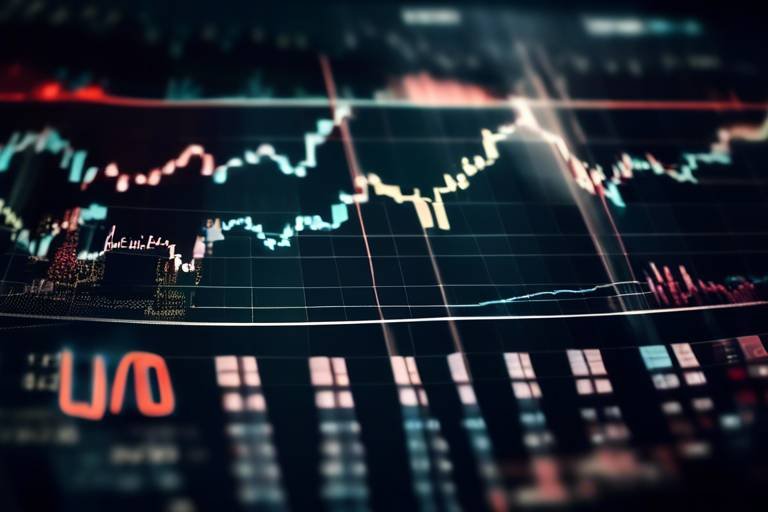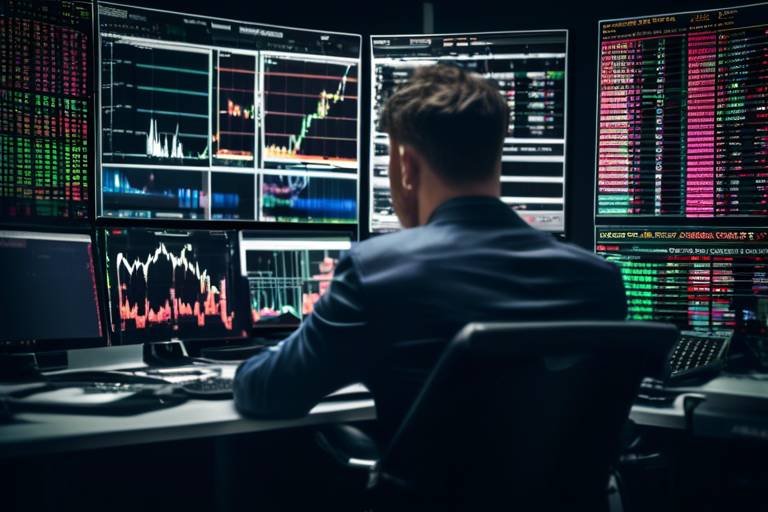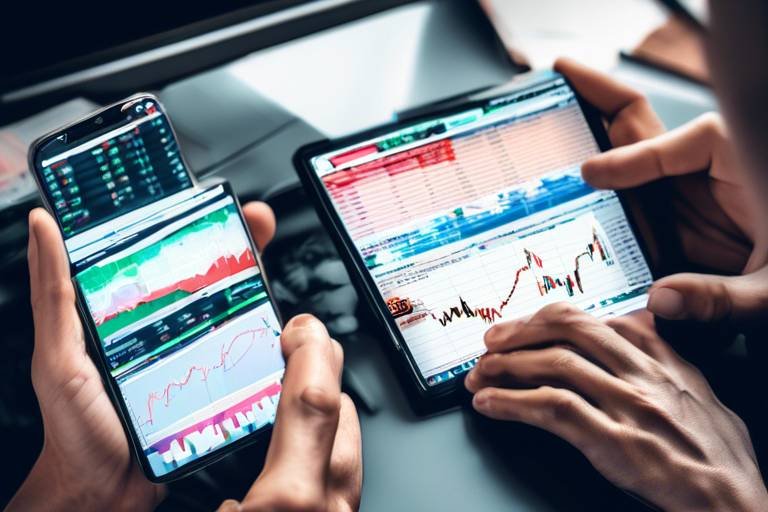The Role of Algorithmic Trading in Cryptocurrencies
In the fast-paced world of cryptocurrencies, where fortunes can change in the blink of an eye, algorithmic trading has emerged as a powerful tool for traders and investors alike. But what exactly does this mean for the average crypto enthusiast? Well, let's dive into the depths of algorithmic trading, its significance, and how it reshapes the trading landscape.
At its core, algorithmic trading refers to the use of computer algorithms to execute trades automatically based on predefined criteria. Think of it as having a highly efficient robot at your disposal, tirelessly analyzing market conditions, crunching numbers, and executing trades at lightning speed. This technology has revolutionized the way we approach trading in the volatile cryptocurrency market, offering a myriad of advantages that traditional trading methods simply can't match.
Imagine trying to catch a butterfly with your bare hands while it's flitting around—it's almost impossible! Now, picture having a net that can swoop in at just the right moment. That's what algorithmic trading does for traders. It allows them to seize fleeting market opportunities that might vanish before a human trader can even blink. With algorithms capable of executing trades in milliseconds, the potential for profit becomes significantly more attainable.
However, it's not all sunshine and rainbows. The world of algorithmic trading comes with its own set of challenges. Technical failures, market volatility, and regulatory concerns can pose serious risks for traders who rely heavily on automated systems. Yet, despite these challenges, the benefits often outweigh the drawbacks, making algorithmic trading an essential component of modern cryptocurrency trading strategies.
As we explore the various aspects of algorithmic trading, we will uncover its advantages, the strategies employed by traders, and the potential future developments that could further enhance its role in the cryptocurrency market. Buckle up, because this journey through the world of algorithmic trading is bound to be exhilarating!
- What is algorithmic trading?
Algorithmic trading involves using computer algorithms to automate the trading process based on specific criteria, allowing for faster and more efficient trading.
- What are the advantages of algorithmic trading?
Some advantages include enhanced speed, reduced emotional decision-making, and the ability to analyze large datasets quickly.
- What are the challenges of algorithmic trading?
Challenges include technical failures, unpredictable market volatility, and regulatory issues that can impact trading strategies.
- What strategies are commonly used in algorithmic trading?
Popular strategies include arbitrage trading and market making, both of which leverage algorithms to capitalize on market inefficiencies.

Understanding Algorithmic Trading
Algorithmic trading is a fascinating concept that has revolutionized the way traders interact with the financial markets, particularly in the fast-paced world of cryptocurrencies. At its core, algorithmic trading involves the use of computer algorithms to automatically execute trades based on predefined criteria. This means that instead of manually placing trades, traders can set specific parameters, and the algorithm takes over, executing trades in a fraction of a second. Imagine having a super-fast assistant who never gets tired or emotional—that’s what algorithmic trading brings to the table!
The mechanics behind algorithmic trading are both intricate and powerful. Algorithms can process vast amounts of data at lightning speed, analyzing market trends, price movements, and trading volumes to identify profitable opportunities. For instance, a trader might set up an algorithm to buy a cryptocurrency when its price drops below a certain threshold and sell it when it rises above another. This level of precision and speed is something that human traders simply cannot match, especially in the highly volatile cryptocurrency market, where prices can fluctuate wildly within minutes.
Let's break down the key components of algorithmic trading:
- Data Analysis: Algorithms sift through historical and real-time data to make informed trading decisions.
- Execution: Once the criteria are met, the algorithm executes the trade instantly, ensuring that the trader doesn't miss out on opportunities.
- Backtesting: Traders can test their algorithms against historical data to see how they would have performed, allowing for adjustments before going live.
The beauty of algorithmic trading lies in its ability to eliminate human biases. Emotions can cloud judgment, leading to poor trading decisions. By relying on algorithms, traders can stick to their strategies without the interference of fear or greed. Furthermore, as the cryptocurrency market continues to grow, the demand for algorithmic trading solutions is expected to increase, making it a vital tool for both new and experienced traders.
In summary, understanding algorithmic trading is crucial for anyone looking to navigate the complexities of the cryptocurrency market. It offers a blend of speed, efficiency, and data-driven decision-making that can significantly enhance trading performance. As we delve deeper into this topic, we will explore its advantages, challenges, and the various strategies employed by traders in the ever-evolving landscape of cryptocurrencies.

Advantages of Algorithmic Trading
Algorithmic trading is revolutionizing the way traders engage with the cryptocurrency market, and its advantages are hard to ignore. First and foremost, one of the standout benefits is speed and efficiency. Imagine being able to execute trades in milliseconds—this is what algorithms bring to the table. In a market that's as volatile as cryptocurrencies, where prices can swing wildly in seconds, this speed allows traders to seize opportunities that would be impossible to catch with manual trading methods.
Furthermore, algorithms can process and analyze vast amounts of data at lightning speed. This capability means that traders can make informed decisions based on real-time market conditions. For instance, when a sudden price shift occurs, an algorithm can assess trends, historical data, and even social sentiment much faster than any human could. This is crucial in the cryptocurrency landscape, where every second counts.
Another significant advantage is the reduction of emotional decision-making. Let's face it: trading can be an emotional rollercoaster. Fear and greed can cloud judgment, leading to hasty decisions that may not align with a trader's strategy. By automating the trading process, algorithms eliminate these emotional biases. Traders can set their parameters and let the algorithms execute trades based on logic and data rather than gut feelings. This leads to more consistent trading performance and can significantly improve overall profitability.
Moreover, algorithmic trading minimizes the risk of human error. In the heat of the moment, it's easy to miscalculate trade sizes or enter incorrect orders. Algorithms, on the other hand, follow predefined instructions precisely. They don't get flustered or distracted, which means they can execute trades at the right time and at the right price—something that is especially important in the fast-paced world of cryptocurrencies.
In addition to these primary advantages, algorithmic trading can also facilitate diversification. Traders can deploy multiple algorithms simultaneously across various assets and exchanges. This not only spreads risk but also allows for the exploitation of different trading strategies at the same time. For example, a trader might use one algorithm for arbitrage opportunities while another focuses on trend-following strategies. This level of diversification is challenging to achieve through manual trading.
Lastly, let's not forget about the accessibility that algorithmic trading provides. With the right tools and knowledge, even novice traders can leverage sophisticated strategies that were once reserved for institutional investors. This democratization of trading technology means that anyone with an internet connection and a bit of knowledge can participate in the market, potentially leveling the playing field.
In summary, the advantages of algorithmic trading in cryptocurrencies are numerous and compelling. From speed and efficiency to emotional control and error reduction, these benefits position algorithmic trading as a formidable tool for both new and experienced traders. As the cryptocurrency market continues to evolve, embracing algorithmic trading could be the key to staying competitive.
- What is algorithmic trading? Algorithmic trading refers to the use of computer algorithms to automate the trading process based on predefined criteria.
- How does algorithmic trading benefit traders? It increases speed, reduces emotional decision-making, minimizes human error, and allows for diversification.
- Is algorithmic trading suitable for beginners? Yes, with the right tools and knowledge, beginners can effectively use algorithmic trading strategies.
- What are the risks associated with algorithmic trading? Risks include technical failures, market volatility, and potential regulatory issues.

Speed and Efficiency
When it comes to trading in the fast-paced world of cryptocurrencies, speed and efficiency are not just advantages; they are essential. Imagine trying to catch a bus that only comes once every hour. If you're not there on time, you miss it. The same principle applies to trading. In the cryptocurrency market, opportunities can vanish in the blink of an eye, and algorithmic trading is like having a super-fast vehicle that ensures you never miss that bus.
Algorithmic trading systems can execute trades in a matter of milliseconds. This speed allows traders to capitalize on fleeting market movements that traditional manual trading simply cannot match. For instance, consider a scenario where the price of Bitcoin drops momentarily due to a sudden market reaction. An algorithm can quickly analyze this price change, determine if it meets the predefined criteria set by the trader, and execute the trade instantly. In this way, traders can seize opportunities that would otherwise be lost, leading to potentially higher profits.
Moreover, the efficiency of these algorithms extends beyond just speed. They are designed to analyze vast amounts of market data in real-time. With the cryptocurrency market being notoriously volatile, having the ability to process and interpret data quickly is invaluable. Algorithms can sift through historical data, current market trends, and various indicators to make informed decisions, all while you might still be trying to figure out what the latest meme coin is all about!
To illustrate this point, consider the following table that compares traditional trading methods with algorithmic trading:
| Aspect | Traditional Trading | Algorithmic Trading |
|---|---|---|
| Execution Speed | Seconds to minutes | Milliseconds |
| Data Analysis | Manual, slower | Automated, real-time |
| Emotional Influence | High | None |
| Market Opportunities | Limited | Maximized |
As you can see, the differences are striking. In a market where every second counts, the ability to execute trades at lightning speed while also analyzing data efficiently can make a significant difference in a trader's success. No longer do traders need to sit glued to their screens, anxiously waiting for the right moment to act. Instead, they can set their algorithms to work, allowing them to focus on other important aspects of their trading strategy or even take a break.
In conclusion, the speed and efficiency offered by algorithmic trading not only enhance a trader's ability to respond to market changes but also reduce the stress associated with trading. It’s like having a high-performance sports car in a race, giving you the edge over competitors who are still stuck in traffic. As we continue to navigate the ever-evolving landscape of cryptocurrency, embracing these technological advancements will undoubtedly be a game-changer for traders looking to stay ahead of the curve.
- What is algorithmic trading? Algorithmic trading is the use of computer algorithms to automate the execution of trades based on predefined criteria.
- How does speed impact trading? Speed allows traders to capitalize on fleeting market opportunities, executing trades in milliseconds compared to seconds or minutes with manual trading.
- What are the risks of algorithmic trading? Risks include technical failures, market volatility, and regulatory issues that can impact the effectiveness of trading strategies.
- Can beginners use algorithmic trading? Yes, many platforms offer user-friendly tools for beginners to set up basic algorithms without extensive programming knowledge.

Market Analysis
When it comes to trading cryptocurrencies, is not just a buzzword; it's the lifeblood of successful trading strategies. In the fast-paced world of digital currencies, where prices can swing wildly in a matter of minutes, having a robust method to analyze market data is essential. Algorithmic trading takes this necessity to the next level by leveraging the power of technology to sift through vast amounts of data in real-time. This means that traders can respond to market movements almost instantaneously, making decisions based on cold, hard data rather than gut feelings.
One of the most significant advantages of algorithmic trading is its ability to analyze multiple data points simultaneously. For instance, an algorithm can monitor price trends, trading volumes, and even social media sentiment to gauge market mood. Imagine trying to do all that manually—it's overwhelming! Algorithms can perform complex calculations and analyses that would take a human hours, if not days, to complete. This speed and efficiency allow traders to spot patterns and trends that might otherwise go unnoticed.
Moreover, the volatility of the cryptocurrency market adds another layer of complexity. Prices can fluctuate dramatically due to various factors, such as regulatory news, market sentiment, or technological advancements. Algorithms can be programmed to react to these fluctuations in real-time, executing trades based on predefined criteria. For example, if the price of Bitcoin drops by a certain percentage within a short timeframe, an algorithm can trigger a buy order automatically, allowing traders to capitalize on lower prices without being glued to their screens.
However, it's important to note that while algorithmic trading can provide a significant edge, it is not foolproof. The effectiveness of market analysis through algorithms depends heavily on the quality of the data being analyzed. Poor data can lead to incorrect conclusions, and in the volatile world of cryptocurrencies, that can be costly. Therefore, traders must ensure they are using reliable data sources and continuously updating their algorithms to adapt to changing market conditions.
In summary, through algorithmic trading is a game-changer for cryptocurrency traders. It offers speed, efficiency, and the ability to analyze vast amounts of data, allowing for informed decision-making in a highly volatile environment. As technology continues to advance, the methods and tools available for market analysis will only become more sophisticated, providing traders with even greater opportunities to succeed.
- What is algorithmic trading? Algorithmic trading uses computer algorithms to automate trading decisions based on specific criteria.
- How does market analysis benefit algorithmic trading? It enables traders to make data-driven decisions quickly, enhancing their ability to respond to market changes.
- What are the risks associated with algorithmic trading? Risks include technical failures, reliance on data quality, and potential market manipulation.
- Can beginners use algorithmic trading? Yes, but it's essential for beginners to understand the underlying principles and risks before diving in.

Reduced Human Error
One of the most significant advantages of algorithmic trading is its ability to dramatically reduce human error. In the fast-paced world of cryptocurrency trading, where every second counts, the potential for mistakes can be high. Think about it: when you're trading manually, emotions can run wild. You might panic during a market dip, leading to hasty decisions that could cost you dearly. Algorithms, on the other hand, operate on pre-set parameters and logic, completely removing the emotional component from trading.
This automation means that trades are executed based on data and analysis rather than gut feelings or momentary fear. For instance, a trader might set an algorithm to buy Bitcoin when it drops below a certain price point and sell when it rises above another. This kind of precision is impossible to maintain consistently when trading manually, especially during periods of high volatility.
Moreover, algorithmic trading systems can handle large volumes of data and execute numerous trades simultaneously, something no human could do without making mistakes. Imagine trying to track multiple price points across various exchanges while also managing your portfolio—it's a recipe for error. Algorithms can analyze market trends, execute trades, and even adjust strategies in real-time without the risk of miscalculating trade sizes or entering trades at unfavorable prices due to momentary lapses in judgment.
To illustrate, consider the following table that outlines common human errors in trading versus the precision of algorithmic trading:
| Human Errors | Algorithmic Trading Benefits |
|---|---|
| Emotional Decision-Making | Trades executed based on logic and data |
| Misjudging Market Trends | Real-time analysis of market data |
| Inconsistent Trading Strategies | Consistent application of trading algorithms |
| Slow Reaction Times | Instantaneous trade execution |
In conclusion, the reduction of human error through algorithmic trading not only enhances the efficiency of trading strategies but also provides traders with the confidence to make decisions based on data rather than emotions. This shift towards automation is becoming increasingly vital in the volatile cryptocurrency market, where the stakes are high and the margin for error is slim.

Challenges of Algorithmic Trading
While algorithmic trading has revolutionized the way we engage with the cryptocurrency market, it is not without its challenges. One of the primary concerns is the potential for technical failures. Imagine you're in the middle of a high-stakes game of poker, and suddenly your cards disappear. That's what can happen when an algorithm malfunctions. These failures can lead to unexpected losses or missed opportunities, creating a sense of uncertainty that can be particularly daunting for traders who rely heavily on technology.
Another significant challenge is the inherent volatility of the cryptocurrency market. Unlike traditional markets, cryptocurrencies can experience wild price swings in a matter of minutes. This volatility can render algorithms ineffective, as they may not be able to adapt quickly enough to rapidly changing conditions. For instance, an algorithm designed to buy when prices dip might trigger a purchase during a sharp downturn, leading to substantial losses instead of gains.
Moreover, regulatory concerns loom large in the world of algorithmic trading. As governments and regulatory bodies scramble to keep pace with the fast-evolving crypto landscape, traders may find themselves navigating a complex web of rules and regulations. This uncertainty can hinder algorithmic strategies, as traders must constantly adapt to new compliance requirements. For example, certain algorithms may need to be adjusted to adhere to anti-money laundering (AML) laws or know your customer (KYC) regulations, which can complicate trading strategies.
Additionally, the market structure itself poses challenges. The cryptocurrency market is fragmented, with numerous exchanges operating independently. This fragmentation can lead to inconsistencies in pricing and liquidity, making it difficult for algorithms to function optimally. Traders may find that an algorithm performing well on one exchange may struggle on another due to varying market conditions. This inconsistency can create a sense of frustration, as traders must continuously monitor and tweak their algorithms to ensure they remain effective across different platforms.
Finally, there’s the issue of over-optimization. In the quest to create the perfect algorithm, traders may inadvertently develop a system that performs exceptionally well on historical data but fails to deliver in real-time trading. This phenomenon, known as curve fitting, can lead to false confidence in an algorithm's capabilities. It’s akin to training for a marathon by only running on a treadmill; you may be prepared for the workout, but the actual race could present unforeseen challenges.
In summary, while algorithmic trading offers exciting opportunities in the cryptocurrency market, it is essential to remain aware of its challenges. By understanding the potential pitfalls—such as technical failures, market volatility, regulatory issues, and over-optimization—traders can better prepare themselves to navigate the complexities of this dynamic environment.
- What is algorithmic trading? - Algorithmic trading involves using computer algorithms to automate trading decisions based on predefined criteria.
- What are the main advantages of algorithmic trading? - Key benefits include speed, efficiency, reduced emotional decision-making, and the ability to analyze large volumes of data quickly.
- What are the risks associated with algorithmic trading? - Risks include technical failures, market volatility, regulatory challenges, and the potential for over-optimization.
- How can I mitigate the risks of algorithmic trading? - Traders can mitigate risks by diversifying strategies, continuously monitoring algorithms, and staying informed about market conditions and regulations.

Algorithmic Trading Strategies
When it comes to algorithmic trading, the strategies employed can make a significant difference in a trader's success. Just like a chef needs the right recipe to whip up a delicious dish, traders require well-defined strategies to navigate the complex waters of the cryptocurrency market. Each strategy is tailored to specific market conditions and trader objectives, allowing for a more systematic approach to trading. In this section, we’ll dive into some of the most popular algorithmic trading strategies that cryptocurrency traders utilize to maximize their profits and minimize risks.
One of the most widely recognized strategies is Arbitrage Trading. This technique takes advantage of price discrepancies that exist across different exchanges. Imagine spotting a pair of shoes that are being sold for $100 on one website and $120 on another; if you were quick enough, you could buy them on the cheaper site and sell them for a profit on the more expensive one. Similarly, algorithmic trading allows traders to identify these price gaps in real-time and execute trades almost instantaneously. By leveraging algorithms, traders can automate the process of buying low on one exchange and selling high on another, thereby capitalizing on these fleeting opportunities.
Another popular strategy is Market Making. This involves providing liquidity to the market by placing both buy and sell orders, creating a market for others to trade in. Think of it as being a middleman in a bustling marketplace, where you buy goods at one price and sell them at a slightly higher price. Algorithms can facilitate market making by constantly updating orders based on market conditions, ensuring that the trader can profit from the spread between the buy and sell prices. However, while this strategy can be lucrative, it also carries risks, especially during periods of high volatility when prices can swing dramatically.
To better understand these strategies, let’s look at a comparison table:
| Strategy | Description | Pros | Cons |
|---|---|---|---|
| Arbitrage Trading | Exploits price differences across exchanges. | Quick profits, low risk if executed correctly. | Requires fast execution and can be impacted by transaction fees. |
| Market Making | Provides liquidity by placing both buy and sell orders. | Consistent income from spreads, helps stabilize the market. | Risk of holding assets during price drops. |
Additionally, there are several other strategies that traders might consider, such as Trend Following, which involves analyzing market trends to make predictions about future price movements, or Mean Reversion, which is based on the idea that prices will revert to their historical average over time. Each of these strategies has its own set of rules and algorithms that traders can customize to suit their individual trading styles.
Ultimately, the effectiveness of these strategies hinges on the trader's ability to adapt them to the ever-changing landscape of the cryptocurrency market. With the right combination of strategy, technology, and market knowledge, algorithmic trading can be a powerful tool for enhancing trading performance. So, whether you're a seasoned trader or just starting out, understanding these strategies can provide you with a competitive edge in the bustling world of cryptocurrency trading.
Here are some common questions traders have about algorithmic trading strategies:
- What is algorithmic trading? - Algorithmic trading uses computer algorithms to automate the trading process based on predefined criteria.
- How can I start with algorithmic trading? - You can start by learning about different strategies, setting up trading software, and practicing with demo accounts.
- What are the risks associated with algorithmic trading? - Risks include technical failures, market volatility, and the potential for significant losses if algorithms are not properly configured.

Arbitrage Trading
Arbitrage trading is a fascinating strategy that allows traders to capitalize on price discrepancies across different cryptocurrency exchanges. Imagine walking into two stores selling the same product but at different prices; wouldn’t you buy from the cheaper store and sell it at a profit in the more expensive one? That’s the essence of arbitrage! In the ever-volatile world of cryptocurrencies, where prices can vary significantly from one exchange to another, this strategy becomes even more appealing.
To successfully engage in arbitrage trading, traders rely on sophisticated algorithms that can quickly identify these price differences and execute trades at lightning speed. The process typically involves three steps: identifying an opportunity, executing the trade, and closing the position. Let’s break it down:
- Identifying Opportunities: Algorithms scan multiple exchanges simultaneously to find discrepancies in prices for the same cryptocurrency. For instance, if Bitcoin is priced at $30,000 on Exchange A and $30,200 on Exchange B, the algorithm will flag this as an opportunity.
- Executing Trades: Once an opportunity is identified, the algorithm executes a buy order on the cheaper exchange and a sell order on the more expensive one, all within milliseconds. This speed is crucial because price discrepancies can vanish in an instant.
- Closing the Position: After executing the trades, the trader closes the position, realizing the profit made from the difference in prices.
However, while arbitrage trading can be lucrative, it’s not without its challenges. For one, the transaction fees charged by exchanges can quickly eat into profits. Additionally, the speed of execution is paramount; if the algorithm isn’t fast enough, the price difference may disappear before the trade is completed. Moreover, market conditions can change rapidly, leading to potential losses if the market moves against the trader's position.
To illustrate the potential of arbitrage trading, let’s take a look at a simplified example:
| Exchange | Price of Bitcoin | Action |
|---|---|---|
| Exchange A | $30,000 | Buy |
| Exchange B | $30,200 | Sell |
In this example, if a trader buys 1 Bitcoin on Exchange A for $30,000 and sells it on Exchange B for $30,200, they would make a profit of $200, minus any transaction fees. This simple yet effective strategy highlights the potential earnings available in the crypto market for those who can leverage technology to act swiftly.
In conclusion, arbitrage trading represents a compelling opportunity within the cryptocurrency landscape. With the right algorithms and a keen eye for market discrepancies, traders can effectively navigate the complexities of the market and enhance their trading strategies. However, it's essential to remain vigilant and aware of the risks involved, as the world of cryptocurrencies is notoriously unpredictable.
- What is arbitrage trading? Arbitrage trading is a strategy that involves buying and selling the same asset on different exchanges to profit from price discrepancies.
- How do algorithms help in arbitrage trading? Algorithms can analyze multiple exchanges simultaneously to identify price differences and execute trades much faster than a human trader could.
- What are the risks associated with arbitrage trading? The main risks include transaction fees, market volatility, and the potential for price discrepancies to disappear before trades can be executed.
- Is arbitrage trading suitable for beginners? While it can be profitable, beginners should be cautious due to the technical knowledge required and the inherent risks involved.

Market Making
Market making is a crucial aspect of the cryptocurrency trading ecosystem, serving as the backbone that ensures liquidity in the markets. Essentially, market makers are traders or firms that provide liquidity by placing both buy and sell orders for a particular asset. This practice is vital because it helps to narrow the bid-ask spread, making it easier for traders to enter and exit positions without significant price fluctuations. Imagine walking into a bustling marketplace where goods are readily available; that’s what market making does for cryptocurrencies—it keeps the market active and vibrant.
The role of algorithms in market making cannot be overstated. With the rapid pace of trading in the cryptocurrency space, algorithms can place orders at lightning speed, responding to market changes in real-time. For instance, if a sudden surge in buying interest occurs, an algorithm can quickly adjust its orders to capitalize on this momentum. This speed not only enhances the market maker's profitability but also benefits other traders by providing them with better prices and quicker execution times.
However, while the rewards can be substantial, market making also comes with its fair share of risks. The primary risk is the potential for significant losses if the market moves against the market maker's positions. To mitigate this, many market makers employ sophisticated strategies that include dynamic pricing models and risk management techniques. For example, they might use statistical arbitrage models to predict price movements or set stop-loss orders to limit potential losses.
Here's a brief overview of the market making process:
| Step | Description |
|---|---|
| 1 | Place buy and sell orders in the market to create liquidity. |
| 2 | Monitor market conditions and adjust orders based on price movements. |
| 3 | Utilize algorithms to execute trades at optimal prices quickly. |
| 4 | Manage risks through various strategies, including hedging and stop-loss orders. |
In conclusion, market making plays a pivotal role in the cryptocurrency markets by ensuring liquidity and facilitating smoother trading experiences. As technology continues to advance, the methods and strategies employed by market makers will likely evolve, making it an exciting area to watch for both traders and investors. The integration of artificial intelligence and machine learning into market making strategies could lead to even more efficient trading practices, further enhancing the overall market dynamics.
- What is market making in cryptocurrencies?
Market making involves placing buy and sell orders to provide liquidity in the market, helping to reduce the bid-ask spread. - How do algorithms assist in market making?
Algorithms can execute trades at high speeds and adjust orders based on real-time market conditions, enhancing efficiency. - What risks are associated with market making?
Market makers face risks such as price volatility and potential losses if the market moves against their positions. - Can anyone be a market maker?
While anyone can technically become a market maker, it often requires significant capital, advanced strategies, and access to trading technology.

The Future of Algorithmic Trading in Cryptocurrencies
As we look towards the horizon of the cryptocurrency market, it's clear that algorithmic trading is poised to undergo significant transformations. The intersection of technology and finance is evolving at a breakneck pace, and algorithmic trading is no exception. With advancements in artificial intelligence, machine learning, and big data analytics, traders and investors are on the brink of a new era where algorithms will not only execute trades but also learn and adapt to market conditions in real-time.
Imagine a world where your trading algorithm can analyze market sentiment by scanning social media, news articles, and even public sentiment on platforms like Reddit or Twitter. This capability could provide traders with a competitive edge, allowing them to anticipate market movements before they happen. The future of algorithmic trading is not just about speed; it's about intelligence. Algorithms that can learn from historical data and adjust their strategies accordingly will likely dominate the landscape.
Moreover, the rise of decentralized finance (DeFi) is reshaping the way traders interact with cryptocurrencies. Traditional exchanges are being supplemented, or even replaced, by decentralized platforms where algorithmic trading strategies can be deployed in a permissionless environment. This shift opens up new opportunities for liquidity provision and arbitrage, as traders can exploit price discrepancies across various DeFi protocols.
However, with great power comes great responsibility. The increasing reliance on algorithmic trading raises concerns about market manipulation and the potential for flash crashes. As algorithms execute trades at lightning speed, a single erroneous line of code could trigger a cascade of sell-offs, leading to significant market volatility. Thus, regulatory bodies are likely to impose stricter guidelines to ensure that these automated systems operate within safe parameters.
In addition, the integration of blockchain technology into algorithmic trading could enhance transparency and security. Smart contracts can automate trade execution based on predefined conditions, reducing the need for intermediaries and minimizing the risk of fraud. This could lead to a more democratized trading environment where anyone with an internet connection can participate.
As we venture further into this digital age, the importance of collaboration between technologists and traders will become increasingly vital. Traders will need to understand the underlying algorithms that power their strategies, while developers must remain attuned to the needs and behaviors of the trading community. This symbiotic relationship could foster innovations that push the boundaries of what is currently possible in the realm of cryptocurrency trading.
To sum up, the future of algorithmic trading in cryptocurrencies is bright, filled with possibilities and challenges. As the market continues to evolve, traders who embrace technology and adapt to these changes will likely find themselves at the forefront of this exciting frontier. The path ahead may be fraught with uncertainty, but those willing to navigate it will reap the rewards of a rapidly changing landscape.
- What is algorithmic trading? Algorithmic trading uses computer algorithms to execute trades based on predefined criteria, allowing for faster and more efficient trading.
- How does algorithmic trading benefit cryptocurrency traders? It offers advantages such as increased speed, reduced emotional decision-making, and the ability to analyze vast amounts of data quickly.
- What are the risks associated with algorithmic trading? Risks include technical failures, market volatility, and potential regulatory issues that can impact trading outcomes.
- How is the future of algorithmic trading expected to evolve? Future trends may include greater integration with AI and machine learning, enhanced security through blockchain, and stricter regulatory oversight.
Frequently Asked Questions
- What is algorithmic trading in cryptocurrencies?
Algorithmic trading in cryptocurrencies refers to using computer programs and algorithms to automatically execute trades based on predefined criteria. This method allows traders to capitalize on market opportunities quickly and efficiently, reducing the time and effort required for manual trading.
- What are the main advantages of using algorithmic trading?
The primary advantages of algorithmic trading include:
- Speed and Efficiency: Algorithms can execute trades in milliseconds, allowing traders to seize fleeting opportunities.
- Data Analysis: Algorithms can analyze vast amounts of market data in real-time, helping traders make informed decisions.
- Reduced Human Error: Automating trades minimizes the risk of errors caused by emotional reactions or miscalculations.
- What challenges do traders face with algorithmic trading?
While algorithmic trading offers numerous benefits, it also comes with challenges such as:
- Technical Failures: System glitches or connectivity issues can lead to missed opportunities or losses.
- Market Volatility: Rapid price changes can affect the performance of algorithms, potentially leading to unexpected results.
- Regulatory Concerns: Different jurisdictions may have varying regulations regarding algorithmic trading, which can complicate compliance.
- What are some popular algorithmic trading strategies?
Some popular algorithmic trading strategies in the cryptocurrency market include:
- Arbitrage Trading: This strategy takes advantage of price discrepancies between different exchanges to make profits.
- Market Making: Market makers provide liquidity by placing buy and sell orders, which algorithms can help optimize.
- How is the future of algorithmic trading expected to evolve?
The future of algorithmic trading in cryptocurrencies is likely to be shaped by advancements in technology, including machine learning and artificial intelligence. These innovations could lead to more sophisticated trading strategies, improved risk management, and enhanced predictive capabilities, making trading even more efficient and effective.


















